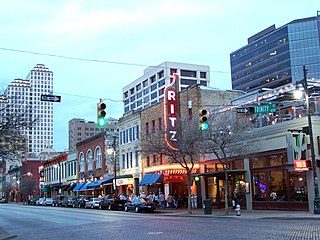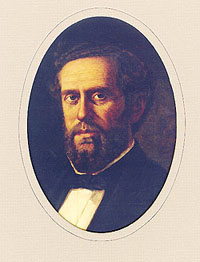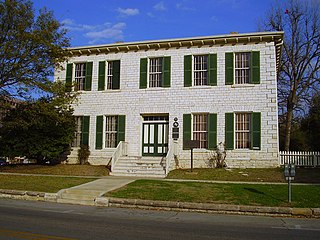
The Texas State Capitol is the capitol and seat of government of the American state of Texas. Located in downtown Austin, Texas, the structure houses the offices and chambers of the Texas Legislature and of the Governor of Texas. Designed in 1881 by architect Elijah E. Myers, it was constructed from 1882 to 1888 under the direction of civil engineer Reuben Lindsay Walker. A $75 million underground extension was completed in 1993. The building was added to the National Register of Historic Places in 1970 and recognized as a National Historic Landmark in 1986.

Sixth Street is a historic street and entertainment district in Austin, Texas, located within the city's urban core in downtown Austin. Sixth Street was formerly named Pecan Street under Austin's older naming convention, which had east–west streets named after trees and north–south streets named after Texas rivers.

John Ireland was the 18th Governor of Texas from 1883 to 1887. During Ireland's term, the University of Texas was established, and construction on the Texas State Capitol began. Ireland is credited with the selection of local pink granite as the construction material.

Austin State Hospital (ASH), formerly known until 1925 as the Texas State Lunatic Asylum, is a 299-bed psychiatric hospital located in Austin, Texas. It is the oldest psychiatric facility in the state of Texas, and the oldest continuously operating west of the Mississippi River. It is operated by the Texas Health and Human Services Commission.

The Texas Historical Commission is an agency dedicated to historic preservation within the U.S. state of Texas. It administers the National Register of Historic Places for sites in Texas.

The Driskill, a Romanesque-style building completed in 1886, is the oldest operating hotel in Austin, Texas, United States, and one of the best-known hotels in Texas generally. The Driskill was conceived and built by Col. Jesse Driskill, a cattleman who spent his fortune constructing "the finest hotel south of St. Louis".

The Dewitt C. Greer State Highway Building is an eight-story structure in downtown Austin, Texas housing offices of the Texas Department of Transportation since its completion. Located at the southwest corner of 11th and Brazos Streets, the building was designed by San Antonio architect Carleton Adams and finished in 1933 at a cost of $455,000. It features elaborate Art Deco styling, including decorative carved limestone panels above the front doors. The building was added to the National Register of Historic Places along with the 1918 State Office Building in 1998.

The Carrington–Covert House is a historic building in downtown Austin, Texas that serves as headquarters of the Texas Historical Commission. Built between 1855 and 1857, it is one of the few surviving pre-Civil War structures in the city.

Fort Griffin, now a Texas state historic site as Fort Griffin State Historic Site, was a US Cavalry fort established 31 July 1867 by four companies of the Sixth Cavalry, U.S. Army under the command of Lt. Col. S. D. Sturgis, in the western part of North Texas, specifically northwestern Shackelford County, to give settlers protection from early Comanche and Kiowa raids. Originally called Camp Wilson after Henry Hamilton Wilson, a recently deceased lieutenant and son of Radical Republican senator and later vice president, Henry Wilson, it was later named for Charles Griffin, a former Civil War Union general who had commanded, as de facto military governor, the Department of Texas during the early years of Reconstruction.

The Blue Bonnet Court, originally called the Bluebonnet Tourist Camp, is a historic motor court-style motel in north-central Austin, Texas. It is located at 4407 Guadalupe Street, Austin, Texas.

Battle Hall, also known as the "Cass Gilbert Building" and "The Old Library," is a historic library on the campus of the University of Texas at Austin in Austin, Texas. It is one of four buildings on campus that have been added to the National Register of Historic Places. The others are the Littlefield House, University Junior High School and Little Campus.

The Arnold Bakery Building is a historic commerce building in east-central Austin, Texas constructed around 1890.

The Haehnel Building is a historic commercial building in east-central Austin, Texas. The building was constructed c. 1880 and served many commercial purposes throughout the 20th century. It was known as Shorty's Bar, a popular hangout for the local population.
The architecture of the U.S. state of Texas comes from a wide variety of sources. Many of the state's buildings reflect Texas' Spanish and Mexican roots; in addition, there is considerable influence from mostly the American South as well as the Southwest. Rapid economic growth since the mid twentieth century has led to a wide variety of contemporary architectural buildings.

The Landmark Inn State Historic Site is a historic inn in Castroville, Texas, United States. It serves the general public as both a state historic site and a bed & breakfast with eight overnight rooms.

O. Henry Hall, formerly known as the U.S. Post Office and Federal Building, is a historic courthouse and post office in Austin, Texas. It is located within the Sixth Street Historic District in Downtown Austin. O. Henry Hall serves as the administrative headquarters of the Texas State University System (TSUS), and until 2017 served as the University of Texas System headquarters.
Jacob Bickler was a scholar, educator, and president of the Texas State Teacher's Association. He was founder of the boys' Texas German and English Academy and the co-educational Bickler Academy, both located in Austin, Texas. In 1969, Recorded Historic Texas Landmark 6438 was placed at the site of the Goodman Building, noting the location on the second floor of Jacob Bickler's German and English academy.

Batts Hall is a building on the South Mall of the University of Texas at Austin campus in Austin, Texas, United States. The five-floor, 39,143-square-foot structure is named after Robert Lynn Batts.

The Burton Commercial Historic District is located in Burton, Texas.

Galveston Orphans Home, also known as Galveston Children's Home, was founded in 1878 by George Dealey (1829-1891) and moved to this location in Galveston, Texas in 1880. The original Gothic revival building was constructed from 1894-1895 with funding from Henry Rosenberg. It was destroyed by the storm of 1900 and newspaper publisher William Randolph Hearst hosted a charity bazaar at the Waldorf-Astoria Hotel in New York City to raise funds for a rebuild. It was completed in 1902. The building was listed on the National Register of Historic Places on March 21, 1979. It is located at 1315 21st Street.



















